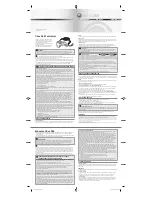
Deploying a Smart Mesh Network
127
NXA-WAPZD1000 ZoneDirector Smart WLAN Controller
Deploying a Smart Mesh Network
Overview of Smart Mesh Networking
A Smart Mesh network is a peer-to-peer, multi-hop wireless network wherein participant nodes cooperate to
route packets. In a Ruckus wireless mesh network, the routing nodes (that is, the Ruckus Wireless APs
forming the network), or “mesh nodes,” form the network's backbone. Clients (for example, laptops and other
mobile devices) connect to the mesh nodes and use the backbone to communicate with one another, and, if
permitted, with nodes on the Internet. The mesh network enables clients to reach other systems by creating a
path that 'hops' between nodes.
Smart Mesh networking offers many advantages:
Smart Mesh networks are self-healing: If any one of the nodes fails, the nodes note the blockage
and re-route data.
Smart Mesh networks are self-organizing: When a new node appears, it becomes assimilated into
the mesh network.
In the Ruckus Wireless Smart Mesh network, all traffic going through the mesh links is encrypted. A
passphrase is shared between mesh nodes to securely pass traffic.
When deployed as a mesh network, Ruckus Wireless APs communicate with the NXA-WAPZD1000 through
a wired LAN connection or through wireless LAN connection with other access points.
Smart Mesh Networking Terms
Before you begin deploying your Smart Mesh network, getting familiar with the following terms that are used
in this document to describe wireless mesh networks is recommended.
Smart Mesh Networking Terms
Term:
Definition:
Mesh Node
A Ruckus Wireless ZoneFlex AP with mesh capability enabled.
Root AP (Root Access Point)
A mesh node communicating to an NXA-WAPZD1000 through its
Ethernet (that is, wired) interface.
Mesh AP (Mesh Access Point)
A mesh node communicating to an NXA-WAPZD1000 through its
wireless interface.
eMAP (Ethernet Mesh AP)
An eMAP is a mesh node that is connected to its uplink AP through a
wired Ethernet cable, rather than wirelessly. eMAP nodes are used to
bridge wireless LAN segments together.
Mesh Tree
Each Mesh AP has exactly one uplink to another Mesh AP or Root AP.
Each Mesh AP or Root AP could have multiple Mesh APs connecting to
it. Thus, the resulting topology is a tree-like topology. There is no limit to
the number of trees in a mesh.
A single NXA-WAPZD1000 can manage more than one mesh tree. The
only limitation on how many mesh trees it can manage is dependent on
the number of APs an NXA-WAPZD1000 can manage. For example, an
NXA-WAPZD1000 1006 can manage a mesh tree of 6 APs or two mesh
trees of 3 APs each.
Hop
The number of wireless mesh links a data packet takes from one Mesh
AP to the Root AP. For example, if the Root AP is the uplink of Mesh AP
1, then Mesh AP 1 is one hop away from the Root AP. In the same
scenario, if Mesh AP 1 is the uplink of Mesh AP 2, then Mesh AP 2 is two
hops away from the Root AP. A maximum of 8 hops is supported.
Содержание NXA-WAPZD1000
Страница 4: ......
Страница 12: ...viii NXA WAPZD1000 ZoneDirector Smart WLAN Controller Table of Contents ...
Страница 16: ...Introduction 12 NXA WAPZD1000 ZoneDirector Smart WLAN Controller ...
Страница 130: ...Blocking Client Devices 126 NXA WAPZD1000 ZoneDirector Smart WLAN Controller ...
Страница 146: ...Smart Mesh Networking Best Practices 142 NXA WAPZD1000 ZoneDirector Smart WLAN Controller ...
Страница 153: ...Troubleshooting 149 NXA WAPZD1000 ZoneDirector Smart WLAN Controller ...
















































